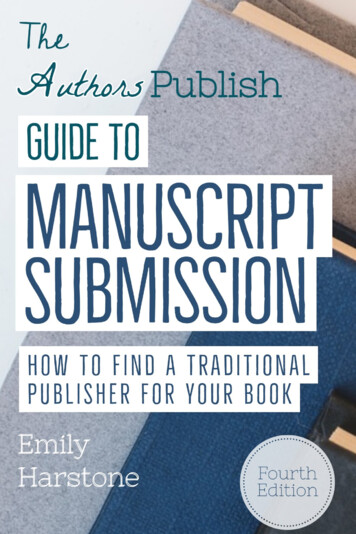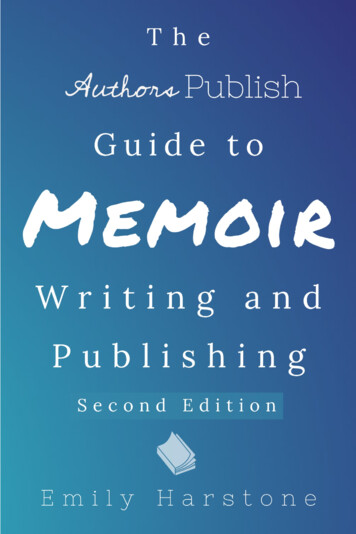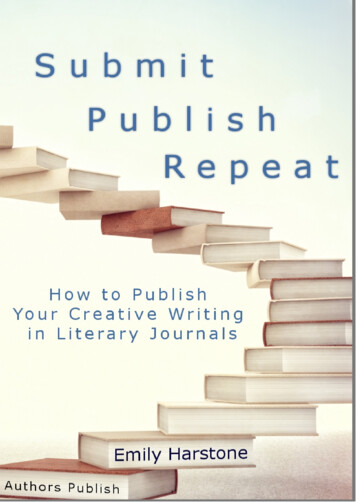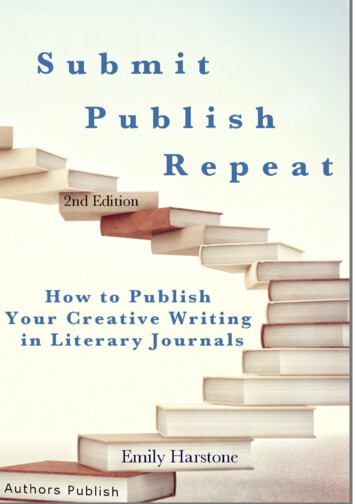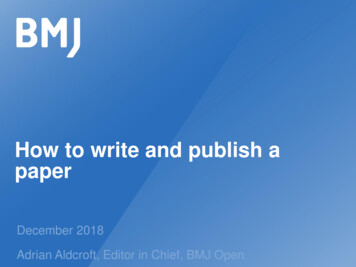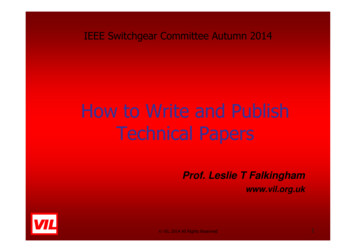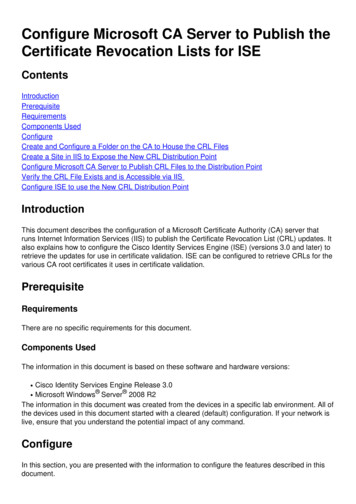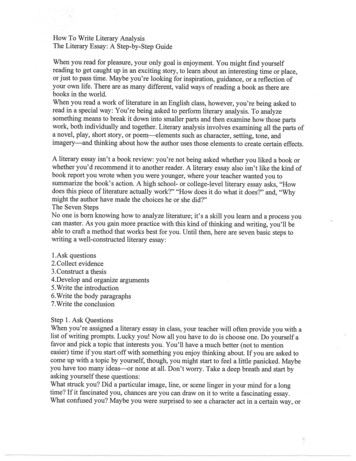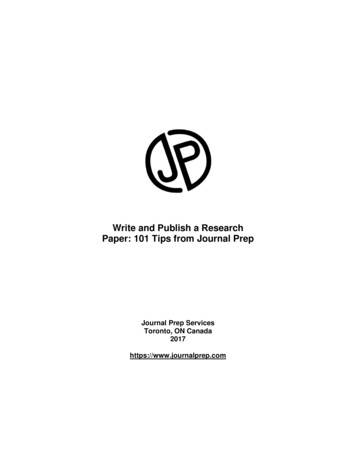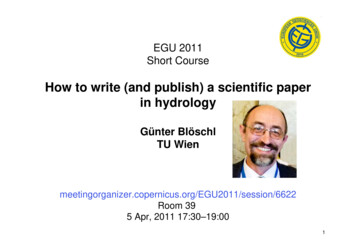
Transcription
EGU 2011Short CourseHow to write (and publish) a scientific paperin hydrologyGünter BlöschlTU n/6622Room 395 Apr, 2011 17:30–19:001
Target group of this presentation: Early stage researchers(doing their PhD)Æ Doing research in hydrology is an art (see Savenije, 2009)Æ But writing a paper is a skill(i.e. simple but needs some practice)Also see excellent talks from previous years:Demetris Koutsoyiannis and Jeff McDonnellhs.egu.eu(I used some of their ideas)Savenije, H. H. G. (2009) The art of hydrology. Hydrology and Earth System Sciences2
My own experiences come from . Paper writing Helping my PhD students & Post Docs to write their papers Reviewing papers Editor/Associate Editor of 10 Hydrology Journals3
Some background of myself1985 Diploma in Civil Engineering at TU Wien1990 Doctorate in Hydrology1992-1994 Visiting fellow in Canberra, Australia1997 Assoc. Prof. of Hydrology2007 Chair of Hydrology and Water Resources ManagementImportant in my career: Professional friends with shared visionExamples:Rodger Grayson.Shared vision: Dynamic spatial patternsSiva SivapalanShared vision: Scale as a framework4
1. How to write a paperWhy would you like to write a paper? Formal goal: In fulfilment of doing a PhD. Note: A PhD thesistypically consists of 4 journal papers introduction Idealistic goal: To contribute to the international body ofknowledge, to assist others so they can build on your work Career goal: Get a job, succeed in academia, becomeinfluential, .My recommendation:Tell the reader something that is useful to him/herThis will address all 3 goals.Recommended approach: Take the readers’ perspective5
Who is the readership? Mostly: Hydrologists like yourself Or: Practitioners (require different message, style, .) Or: General public (again, different message, style, .)Reader’s perspective means: Make paper useful to the type of reader your are envisagingExample: Focus on Take Home Message (THM, see later) Make the paper clear (and concise) for the type of readeryour are envisagingExample: Reader is likely familiar with hydrology (so no needto repeat hydrology 101 in the paper) but is not familiar withyour data/method (do say exactly what you have been doing) Adjust the style to the readershipExample: Use technical language for fellow hydrologists, useevery day language for general public6
A stepwise guide to writing a paperStep 1: Start with the “take home message” (THM)Try to think what could be the things you have learned in yourresearch that could be useful to hydrologists outside your groupThis is an iterative process, as often you will have to do extraresearch to identify nice Take Home Messages.Example (for a paper on regional flood frequency):THM1: “Spatial distance is a better similarity measure thancatchment attributes.”THM2: “Auxiliary information improves spatial-distance basedregionalisation.”7
Do’s and don’ts of THM Try to be quantitativeExample: “The normalised jack-knife validation error is 0.15 in37 Austrian catchments for the period 1980-2010.” And again, try to be useful to others (by being quantitativeand by generalisable messages)Example: “In the wet catchments, regionalisation performancewas significantly better than in the dry catchments (normalisederrors of 0.12 and 0.23, respectively).” Avoid messages that are only relevant to yourselfExample: “The model provided an excellent fit to the data”Note: You are happy that you made the model fit the data, butthis is only relevant to others if it supports other model results.Example: “The project was successful.”Note: Rather present your results that imply you have done agood job, don’t praise yourself.8
Do’s and don’ts of THM (cont’d) The THM should be “new”. Focus on the new thing (whatsets it apart from the literature).Example: “While most of previous regionalisation studies haveused daily models, this papers analyses the modelperformance at an hourly time step.”Special problem: Your research was part of an applied projectand it is difficult for you to find what is new. Additional analysesare probably needed.Example: Applying model for flood forecasting.Additional analyses: Model performance as afunction of catchment characteristics9
Step 2: Formulate science questionThis is simple once the THM is identified. For the above THMthe science questions (SQs) are.SQ1: Is spatial distance a better similarity measure thancatchment attributes?SQ2: What is the value of auxiliary information in floodregionalisation?Note: The easiest way for a reviewer to kill your paper is to saythere is no science question. So make it explicit (in theintroduction, see later).10
Step 3: Write a preliminary title and select journal,select authorsTitle: Should address the science question Specific titles should be preferred over general titlesJournal: See later (how to publish a paper)Authorship: First author: Who actually did the work, usually the doctoralstudent Last author: Senior author, supervisor Who deserves to be a co-author? Those contributing to paper,including ideas (when in doubt be inclusive)11
So this is what your document should now look like:12
Step 3: Write a preliminary abstractPart 1: Context (no more than 1 sentence, can be omitted)“Estimating flood frequencies is important for . “Part 2: Methods and data (i.e. what you did) (should be nomore than 1/3 of abstract)“We examine the predictive performance of various floodregionalisation methods for the ungauged catchment case,based on a jack-knifing comparison of locally estimated andregionalised flood quantiles for 575 Austrian catchments, 122of which have a record length of 40 years or more.”13
Part 3: Results (should be at least 1/3 of abstract), bequantitative“The main result is that spatial proximity is a significantly betterpredictor of regional flood frequencies than are catchmentattributes (normalised errors of 0.11 and 0.23, respectively). A stratified analysis suggests that in wet catchments allregionalisation methods perform better than they do in drycatchments.”Note: The results include the THM. They are of most use to thereader, so should represent the main part of the abstract.Part 4: Discussion/outlook (no more than 1 sentence, can beomitted)“Implications for hydrological modelling are discussed” or“Further work will focus on . “14
Step 4: Make an outline of the paper including thefiguresOutline: Introduction Data Model (data and model can be combined into methods) Results Discussion Conclusions (last 2 can be combined)15
Example: Draft paperby Magdalena Rogger. then assign thefigures to the sectionsof the paper(see her talkWednesday 9:15room 36)16
Step 5: Write IntroductionPart 1: Context (This is the “wall where to hang the picture” the picture is your paper)Example: “Analysing flood response is important from bothpractical and theoretical perspectives. From a practical .”Part 2: State the issue (this must relate to your THM!)Example: “However, it is unclear what is the best method forestimating flood flow in ungauged catchments .”Part 3: State what others in the literature have found on thisissueExample: “Results of Pfaundler (2001) suggest that floodregionalisation errors using the ROI method are less than 0.20for the 50 Swiss catchments he examined. However, this is atvariance with Tasker .”17
Part 3 (cont’d):Important!!!!: Do not write about your topic in general, butsummarise findings in the literature on the science question.There is little value in writing: “Tasker (1987), Pfaundler (2001),Stedinger (1995) applied regional flood estimation methods”because reader learns little from it.Much better to write what they found. Summarise their TakeHome Messages in the context of your science question.This part should be organised by science questions (or subscience questions – science questions split into parts) in asimilar way as the discussion section (see later).This part can be 2-3 pages.18
Part 4: State the purpose of the paperThis is identical with the science question you identified earlier.Example: “The aim of the paper is to asses the relativeperformance of methods based on spatial distance andmethods based on catchment attributes”Note: The easiest way for a reviewer to kill your paper is to saythere is no science question. So make it explicit.Start the sentence with“The aim of this paper is .“, “The objective of the paper is .”or something similar, so it is clear to the reader what you aretrying to achieve in this paper.19
Part 5 (usually omitted): Readers’ guidePerhaps summarise structure of paper to guide the reader butavoid writing a summary (including methods, findings) of thepaper.Example: “Section 2 presents the data used in the study,section 3 summarises the model .”20
Step 6: Write data sectionStrike a balance of what would be of interest to the reader andwhat would not.Avoid general statements (that can be found in a text book).Example: “A raingauge consists of a cylindrical container .”But give the local details of your data, including study area,geographical location, number of stations, record length,experimental setup etc.Example: “We used a Hellmann XX raingauge Type YY”21
Step 7: Write model sectionThe same principles apply as for the data section, i.e. avoidgeneral statements but give the details of what you actually did.Reader will have knowledge of hydrology but is not familiar withthe particularities of your study.Again, say what you did.Examples: Avoid: “can be calculated”, “may be analysed”Rather say: “We calculated”, “In this study we analysed “If the model description is long it can go into an appendix.22
Step 8: Write results sectionSummarise the findings of your research.This sections contains most of the figures (with the results).State the facts, no speculation is allowed here.The results section follows the order of the figures.Example: “Fig. 3 shows the error statistics of regionalising the100 year floods using the ROI method. As can be seen fromthe figure, the errors tend to decrease with .”23
Step 9: Write discussion sectionHere you interpret your findings in the light of the literature.Need to connect partial findings of your paper to each other.Also need to connect your findings to the literature.Are your results consistent with the literature? Why? Why not?Give the reasons. Just stating that they are different is notenough. You need to say why.Example: “Unlike Pfaundler (2001) the results in this studyindicate that the geostatistical method outperforms the ROImethod. The difference in the two studies are likely due to . “Some speculation is allowed here, provided you are explicitabout it.24
Discussion section often organised differently from resultssection (but not always). Results section: organise by figures (the way you did theanalysis) Discussion section: organise by sub-science questions.Example: “The results in this paper indicated that spatialdistance is a better similarity measure than catchmentattributes. “ This relates to THM1.Then in the next paragraph you can write:“We also found that auxiliary information improves spatialdistance based regionalisation. This would be expected asMerz et al. (2004) ” This relates to THM2.25
Paper is symmetric (apple core) Introduction: literature with interpretationÆ Data/model and results: hard facts (what youÆdid and what you found) Discussion: literature with interpretation and Æconnected to your resultscoreeducationllc.comNote: As an indication of the symmetry, the introduction anddiscussion sections should relate to similar references.- Introduction & discussion sections correspond- Data/model & results sections correspond26
Step 10: Write conclusionsThese are the THMs.You can add an outlook at the end of the paper (not more than2-3 sentences).Example: “Future work will focus on . “Most people state here what they are planning for their nextpaper.Note: Papers that have been written with this framework inmind can be downloaded from: nload-journal-publications.htmlStep 11: Go through the entire manuscript a couple of times until you are happy with it.27
Step 12: Ask your co-authors/colleagues/supervisorto read through the manuscriptThey will likely come back with questions (2 types):(1) Clarification: They did not understand part of what you arewriting.Now the ball is in your court. You need to write the manuscriptin the way they understand it. If they do not understand it,change the paper rather than argue with them.(2) Methodological problems: Some discussion is needed, andpossibly corrections/additional analyses.Note: The same things apply to the review process.Now the paper is ready for submission.28
2. How to publish a paperWhy is publishing important for you? In academia you are mainly judged by the quality and quantityof your journal papersNote: Do not bother with conference proceedings.Main bibliometric criteria: Number of papers (not very useful, but often used) Quality of the journals your are publishing (ISI Impact factor) Number of citations you get for your papersÆ Choice of journal?Æ How to get cited?29
Top hydrology journals (by ISI impact factor)JournalHydrol Earth Syst ScWater Resour ResJ HydrolAdv Water ResourJ Contam HydrolVadose Zone JHydrol ProcessGround WaterHydrolog Sci JHydrol ResImpact : These are all very good journals.Note: Impact factor is a measure of how often papers in thatjournal are cited.30
Choice of journalOther considerations than ISI impact factor often moreimportant for journal choiceExamples of how I am choosing journals:Hydrol Earth Syst ScWater Resour ResJ HydrolAdv Water ResourHydrol ProcessHydrolog Sci JHydrol ResÆ fast, transparent reviewsÆ methodsÆ case studiesÆ methodsÆ field studiesÆ developing countriesÆ cold regions31
How to get cited? Tell reader something that is useful to him/her (see THM)Example: New method that is likely to be used such as vanGenuchten infiltration equation Chose topic that is of much interest (if you can)Example: Estimating runoff model parameters in ungaugedcatchment related to GIS (browse Scopus or ISI Web forcitations. Chose appealing title: Science question is often good titleExample: Is spatial distance a better similarity measure thancatchment attributes? Perhaps consider to write a review paper. These are verywell cited but a lot of work.32
Example: Citations of publications of two newly appointedhydrology professors in EuropeProfessor XProfessor Y33
The editorial/review process(1) Submit paper to journal(2) Paper is sent out by editor to 2-3 reviewers(3) Editor gets back to you with the (anonymous) reviewcomments(4a) Respond to review comments and revise paper(4b) Paper was rejected(5a) Paper will possibly be re-reviewed with re-revision(6a) Paper accepted(7a) Type setting, you need to check proofs(8a) Paper published in journalNote: Entire process may take 0.5 – 2 years34
How to deal with reviewsDecision of Editor is usually either: Minor changes (requiring text changes) Major changes (requiring additional analyses) RejectFrom co-450-estudios-peer-reviewed/35
How to deal with reviews (cont’d)Possible concerns of reviewers:(1) Clarification, language(2) Methodological problems(3) Science question / relevance is unclear(Strong) recommendation: You need to write manuscript inthe way reviewers understand it. If they do not understandit, change the paper rather than argue with them.Note: There are exceptions of poor reviews. Also, reviewsare often not well correlated.36
How to deal with reviews (cont’d)Recommendation: Take the reviewers’ concerns seriously.Their task is (a) screening and (b) improving your paper.Papers can always be improved!Prepare a detailed list of how you respond to each reviewcomment (and send it to Editor along with revision).Example (reviewer comments in italics, response in plain font):“However, it seems unclear how the split sample test wasperformed given that only 3 yrs of data were available”.“This issue was indeed unclear in the original paper. Wehave clarified it by stating that the split sample test wasperformed on data from neighbouring catchments.”37
How to deal with reviews (cont’d)If you disagree with a review comment you may say so andnot change this aspect of your paper but explain why. Donot argue but state your view.Example (reviewer comments in italics, response in plain font):“L as used on p. 12 of the manuscript is not a formallikelihood function. The paper is therefore flawed”.“We believe L is indeed a formal likelihood function. This isbecause We have therefore chosen not to change thisaspect of the paper.”The editor will tend to side with the reviewers, so explain itwell. Also do not disagree with too many items of thereviewers ( 20%), as you will loose credibility.38
How to deal with rejections39
How to deal with rejections(1) Redo the analysis in a way suggested by the reviewers,more data, changed methodology, (2) Possibly combine 2 pieces of research to make a moresubstantial contribution.(3) Chose a different journal. Caveat: Do not submit thepaper to a different journal unchanged!- Chances are it goes to the same reviewers- Take advantage of what the reviewers told you(4) Try something else if you are not convinced about paper(5) Don’t give up if your are convinced though!! Some of themost influential papers have been rejected at first.Example: Beven (1989)Beven, K. (1989) Changing ideas in hydrology - the case of physically based models.40
Once your paper gets acceptedShare your happiness with your colleagues and friendsforgottenclassicsofyesteryear.blogspot.com and think about your next paper41
Final suggestions(1) Go for it! Journal papers will be extremely important foryou if you intend to pursue an academic career.(2) Take the readers’ perspective. Tell the readersomething that is useful to him/her.(3) Know the literature! . to the point where you have readeverything related to your sub-topic.(4) Take reviewers seriously but do not get disappointed ifthey disagree with you (part of the quality assurance).(5) Most universities have writing clinics / courses to helpwith style/language – make use of them.(6) Paper writing is a skill, so it is simple but needs somepractice.42
How to write (and publish) a scientific paper in hydrology. . to repeat hydrology 101 in the paper) but is not familiar with . Then in the next paragraph you can write: “We also found that auxiliary information improves spatial
